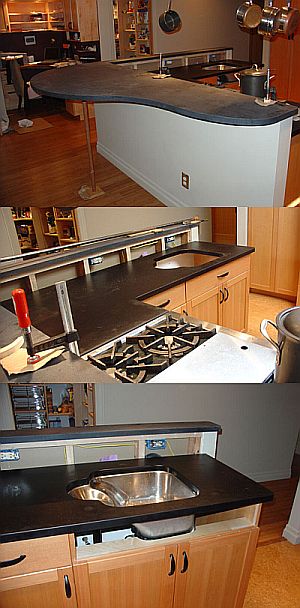Question
I am having difficulties fabricating solid surface. We have too many orders, too many jobs… and our biggest problem is that all work is hand made. Our workshop consists of 20 workers - two for installation, seven for fabrication, and the others are ordinary workers and sanders. What can be introduced to the workshop to make our lives easier (today we stress on a project and work overtime, the next day nobody comes to work or everybody is tired). We use the traditional steps cutting on the table saw, then we do the edge cleaning on a router fixed on a table, then the adhesive, then sanding. Do you think a spindler will make things easier?
Forum Responses
(Laminate and Solid Surface Forum)
I recommend a Striebig vertical panel immediately. After you get that, start looking at a CNC machine and cut down the number of employees (headaches) you have and replace them with headaches you create (CNC). You won't go wrong with a Striebig machine. And then I would seriously consider a CNC.
With regard to your business, there are several things we discovered when fabricating the solid surface material with a CNC. Perhaps, I should say we uncovered a few tricks we were able to do with the CNC. They are as follows:
1. Universal interlocking 1/8 plywood templates were cut to lay just inside the countertop to be measured. A score line was made at 4" intervals around the perimeter of the template. After assembling the template, measurements could be taken from the template to cabinet edge or the wall. Using the CAD drawings of the template, you can now plot points to represent the finished geometry of the countertop. It's sort of a poor man's digitizer, but the results are extremely accurate.
2. When cutting the edge or build up strips, we would drill for dowels at the perimeter so that we could stack the edge without concern of movement.
3. Creating joints is a breeze. They always fit when cut with the router.
4. We would often cut the tops slightly oversized, say about 1/8". After glue up, we would turn the top upside down and reposition it on the CNC. We would then cut the top to desired size, thus cleaning up the edge and associated glue squeeze out.
5. Drainboards and other similar millwork is easily accomplished.
6. We experimented with cutting artwork etched in the face of the material. The cut lines were then filled with the glue material above the surface of the material. After hardening, we milled the surface flat to reveal a clean inlay of our artwork.
These are just a few things we learned in dabbling at the crossroads of where the material meets the machine. It's hard to imagine the tricks, shortcuts and ideas that people like yourself who are in the trenches everyday with the product could come up with. My vote - go with CNC. You won't regret it.
